Solar eclipse of May 29, 1919
A total solar eclipse occurred on Thursday, May 29, 1919. With the duration of totality at maximum eclipse of 6 minutes 50.75 seconds, it was the longest solar eclipse since May 27, 1416. A longer total solar eclipse would later occur on June 8, 1937.[1]
| Solar eclipse of May 29, 1919 | |
|---|---|
 From the report of Sir Arthur Eddington on the expedition to the island of Principe (off the west coast of Africa). | |
 Map | |
| Type of eclipse | |
| Nature | Total |
| Gamma | −0.2955 |
| Magnitude | 1.0719 |
| Maximum eclipse | |
| Duration | 411 sec (6 m 51 s) |
| Coordinates | 4.4°N 16.7°W |
| Max. width of band | 244 km (152 mi) |
| Times (UTC) | |
| Greatest eclipse | 13:08:55 |
| References | |
| Saros | 136 (32 of 71) |
| Catalog # (SE5000) | 9326 |
As it occurred only 0.8 days after perigee (May 28), the Moon's apparent diameter was larger.
It was visible throughout most of South America and Africa as a partial eclipse. Totality occurred through a narrow path across southeastern Peru, northern Chile, central Bolivia and Brazil after sunrise, across the Atlantic Ocean and into south central Africa, covering southern Liberia, southern French West Africa (the part now belonging to Ivory Coast), southwestern tip of British Gold Coast (now Ghana), Príncipe Island in Portuguese São Tomé and Príncipe, southern Spanish Guinea (now Equatorial Guinea), French Equatorial Africa (the parts now belonging to Gabon and R. Congo, including Libreville), Belgian Congo (now DR Congo), northeastern Northern Rhodesia (now Zambia), northern tip of Nyasaland (now Malawi), German East Africa (now belonging to Tanzania) and northeastern Portuguese Mozambique (now Mozambique), ending near sunset in eastern Africa. There was another solar eclipse in 1919, an annular solar eclipse on November 22.
Observations
Albert Einstein's prediction of the bending of light by the gravity of the Sun, one of the components of his general theory of relativity, can be tested during a solar eclipse, when stars with apparent position near the Sun become visible. Following an unsuccessful attempt to validate this prediction during the Solar eclipse of June 8, 1918,[2] two expeditions were made to measure positions of stars during this eclipse (see Eddington experiment). They were organized under the direction of Sir Frank Watson Dyson. One expedition was led by Sir Arthur Eddington to the island of Príncipe (off the west coast of Africa), the other by Andrew Claude de la Cherois Crommelin and Charles Rundle Davidson to Sobral in Brazil.[3][4][5] The stars that both expeditions observed were in the constellation Taurus.[6]
Related eclipses
Solar eclipses 1916–1920
This eclipse is a member of a semester series. An eclipse in a semester series of solar eclipses repeats approximately every 177 days and 4 hours (a semester) at alternating nodes of the Moon's orbit.[7]
| Solar eclipse series sets from 1916–1920 | ||||
|---|---|---|---|---|
| Ascending node | Descending node | |||
| 111 | December 24, 1916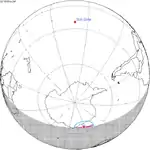 Partial |
116 | June 19, 1917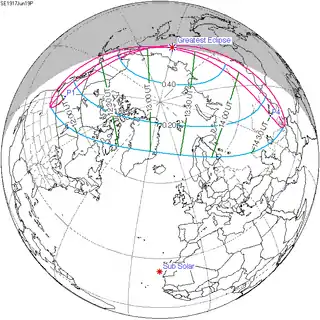 Partial | |
| 121 | December 14, 1917 Annular |
126 | June 8, 1918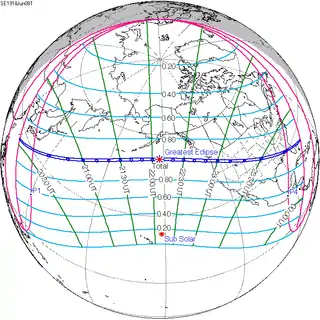 Total | |
| 131 | December 3, 1918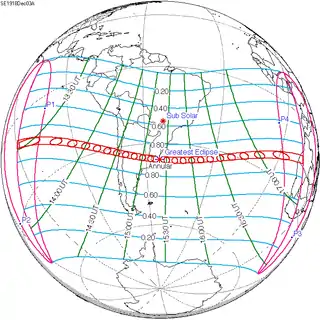 Annular |
136 | May 29, 1919 Total | |
| 141 | November 22, 1919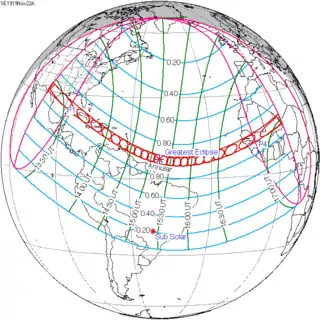 Annular |
146 | May 18, 1920 Partial | |
| 151 | November 10, 1920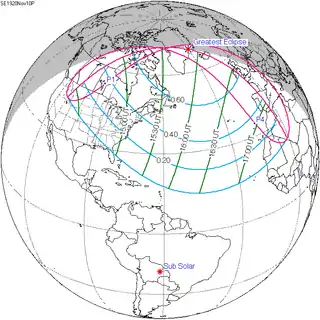 Partial | |||
Saros 136
Solar Saros 136, repeating every 18 years, 11 days, contains 71 events. The series started with partial solar eclipse on June 14, 1360, and reached a first annular eclipse on September 8, 1504. It was a hybrid event from November 22, 1612, through January 17, 1703, and total eclipses from January 27, 1721, through May 13, 2496. The series ends at member 71 as a partial eclipse on July 30, 2622, with the entire series lasting 1262 years. The longest eclipse occurred on June 20, 1955, with a maximum duration of totality at 7 minutes, 7.74 seconds. All eclipses in this series occurs at the Moon's descending node.[8]
| Series members 29–43 occur between 1865 and 2117 | ||
|---|---|---|
| 29 | 30 | 31 |
 Apr 25, 1865 |
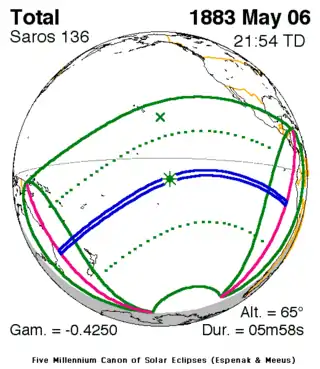 May 6, 1883 |
 May 18, 1901 |
| 32 | 33 | 34 |
 May 29, 1919 |
 Jun 8, 1937 |
 Jun 20, 1955 |
| 35 | 36 | 37 |
 Jun 30, 1973 |
 Jul 11, 1991 |
 Jul 22, 2009 |
| 38 | 39 | 40 |
 Aug 2, 2027 |
 Aug 12, 2045 |
 Aug 24, 2063 |
| 41 | 42 | 43 |
 Sep 3, 2081 |
 Sep 14, 2099 |
 Sep 26, 2117 |
Inex series
This eclipse is a part of the long period inex cycle, repeating at alternating nodes, every 358 synodic months (≈ 10,571.95 days, or 29 years minus 20 days). Their appearance and longitude are irregular due to a lack of synchronization with the anomalistic month (period of perigee). However, groupings of 3 inex cycles (≈ 87 years minus 2 months) comes close (≈ 1,151.02 anomalistic months), so eclipses are similar in these groupings.
| Inex series members between 1901 and 2100: | ||
|---|---|---|
 May 29, 1919 (Saros 136) |
 May 9, 1948 (Saros 137) |
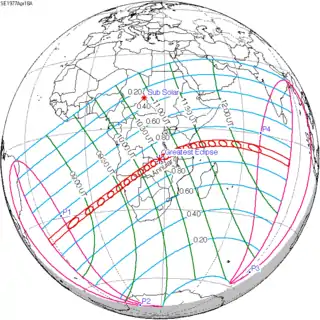 April 18, 1977 (Saros 138) |
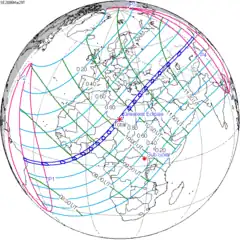 March 29, 2006 (Saros 139) |
 March 9, 2035 (Saros 140) |
 February 17, 2064 (Saros 141) |
 January 27, 2093 (Saros 142) |
||
Notes
- Espenak, Fred. "Total Solar Eclipses with Durations Exceeding 07m 00s: -3999 to 6000". NASA Eclipse Web Site.
- Ethan Siegel, "America's Previous Coast-To-Coast Eclipse Almost Proved Einstein Right", Forbes, Aug 4, 2017. Retrieved August 4, 2017.
- ”Eclipse 1919”, Web site commemorating the 1919 Solar Eclipse expedition, 2019. Retrieved December 10, 2021.
- Longair, Malcolm (2015-04-13). "Bending space–time: a commentary on Dyson, Eddington and Davidson (1920) 'A determination of the deflection of light by the Sun's gravitational field'". Phil. Trans. R. Soc. A. 373 (2039): 20140287. Bibcode:2015RSPTA.37340287L. doi:10.1098/rsta.2014.0287. ISSN 1364-503X. PMC 4360090. PMID 25750149.
- Kennefick, Daniel (2019). No Shadow of a Doubt. Princeton University Press. ISBN 978-0-691-18386-2.
- F. W. Dyson; A. S. Eddington; C. Davidson (1920). "A Determination of the Deflection of Light by the Sun's Gravitational Field, from Observations Made at the Total Eclipse of May 29, 1919". Philosophical Transactions of the Royal Society of London. CCXX-A 579 (571–581): 291–333. Bibcode:1920RSPTA.220..291D. doi:10.1098/rsta.1920.0009.
- van Gent, R.H. "Solar- and Lunar-Eclipse Predictions from Antiquity to the Present". A Catalogue of Eclipse Cycles. Utrecht University. Retrieved 6 October 2018.
- SEsaros136 at NASA.gov
References
- NASA chart and statistics
- Fotos of Solar Corona May 29, 1919
- Wired.com: May 29, 1919: A Major Eclipse, Relatively Speaking
- Famous Eclipse of 1919
.jpg.webp)

